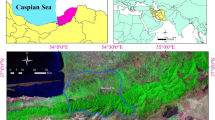Abstract
The land structure in dry-steppe Zavolzh’e is complicated and includes irrigated and rain-fed croplands and pastures in natural steppe areas and on abandoned plow lands, which results in significantly incorrect assessment of the Land Degradation Neutrality (LDN) based on standard approaches elaborated to analyze the land status at the global and regional levels. The problem of interpreting the results of the assessment of the dynamics of land cover as one of the main global indicators of LDN proposed by the UN Convention to Combat Desertification is analyzed in this work. A method based on the analysis of seasonal series of Landsat satellite images, using Kohonen self-organizing neural networks implemented in the Scanex Image Processor software package was developed and applied for the study area. It is shown that this approach makes significantly greater the possibilities of assessing the LDN as a result of the detailed analysis and delineation of a larger number of cartographic areas and when using the transition assessment matrix based on the extended classification of the land cover. The application of the Change Detection module of the SAGA GIS software package enables us not only to identify the nature of restoration and degradation changes, but also to compare the trends for land categories. The combination of the proposed approaches in the form of a functional algorithm may be recommended for monitoring and evaluation of the achieving LDN at the local level.







Similar content being viewed by others
Notes
The size of plots enables their further use as etalons during learning neural nets.
REFERENCES
Belyaeva, M.V., Andreeva, O.V., Kust, G.S., and Lobkovskii, V.A., Experience in assessment of land degradation dynamics of the south of European part of Russia using the methodology of land degradation neutrality, Ekosistemy: Ekologiya i Dinamika, 2020, vol. 4, no. 3, pp. 145–165.
Conard, O., SAGA–GIS Module Library Documentation (v 2.1.3), 2010. https://saga-gis.sourceforge.io/saga_ tool_doc/2.1.3/imagery_classification_2.html. Cited June 2, 2022.
Di Gregorio, A. and Jansen, Louisa J.M., Land Cover Classification System: Classification Concepts and User Manual FAO, 2000. http://www.fao.org/docrep/003/x0596e/X0596e00.htm#P–1_0. Cited June 2, 2022.
Dobrovol’skii, G.V., Fedorov, K.N., Stasyuk, N.V., Mozharova, N.V., and Bykova, E.P., Typification of the soil cover structures of the Dagestan plains and its anthropogenic stability, Pochvovedenie, 1991, no. 3, pp. 5–13.
Huang, D., Wang, K., and Wu, W.L., Dynamics of soil physical and chemical properties and vegetation succession characteristics during grassland desertification under sheep grazing in an agropastoral transition zone in Northern China, Journal of Arid Environments, 2007, vol. 70, no. 1, pp. 120–136.
Karibaeva, K.N. and Kurochkina, L.Ya., Smeny rastitel’nosti i ikh regulirovanie pri pastbishchnom ispol’zovanii (Taukumy) (Vegetation Changes and Their Regulation During Pasture Use (Taukums)), Alma–Ata: Gylym, 1991.
Key, C. and Benson, N., Landscape Assessment: Remote Sensing of Severity, the Normalized Burn Ratio; and Ground Measure of Severity, the Composite Burn Index., in FIREMON: Fire Effects Monitoring and Inventory System, RMRS-GTR, Ogden, UT: USDA Forest Service, Rocky Mountain Research Station, 2006.
Kust, G.S., Andreeva, O.V., and Lobkovskii, V.A., Kust, G.S., Andreeva, O.V., and Lobkovskiy, V.A., Land degradation neutrality: The modern approach to research on arid regions at the national level, Arid Ecosyst. 2020, vol. 10, no. 2, pp. 87–92.
Land cover CCI. Propuct User Guide. Version 2.0. http://maps.elie.ucl.ac.be/CCI/viewer/download/ESACCI–LC–Ph2–PUGv2_2.0.pdf. Cited June 2, 2022.
Mozharova, N.V. and Fedorov, K.N., Evolution of soil mesostructures of the Terek-Kuma lowland accumulative-marine plain, Biol. Nauki, 1990, no. 2, pp. 15–20.
Orr, B.J., Cowie, A.L., Castillo, V.M.S., Chasek, P., Crossman, N.D., Erlewein, A., and Welton, S., Scientific conceptual framework for land degradation neutrality, Bonn, Germany: United Nations Convention to Combat Desertification (UNCCD), A Report of the Science-Policy Interface, 2007. www.unccd.int/resources/publications/scientific–conceptual–framework–land–degradation–neutrality–report–science. Cited June 2, 2022.
Otchet o NIR po gosudarstvennoi teme FMWS–2019–0010 “Razrabotka nauchnykh osnov ustoichivogo upravleniya prirodno–antropogennymi sistemami na osnove modelei sbalansirovannogo zemlepol’zovaniya (zaklyuchitel’nyi)" (Research Report on the State Topic FMWS-2019-0010 “Development of Scientific Foundations for Sustainable Management of Natural and Anthropogenic Systems Based on Balanced Land Use Models (Final)”), Institut Geografii Ross. Akad Nauk, Moscow, 2021.
Programma obrabotki dannykh distantsionnogo zondirovaniya ScanEx Image Processor v 5.1. Modul’ tematicheskoi interpretatsii (Tematik Pro). Rukovodstvo pol’zovatelya (Remote Sensing Data Processing Program ScanEx Image Processor v 5.1. Thematic Interpretation Module (Thematic Pro). User’s manual), Moscow, 2019.
Quinn, J.W., Summary of Band Combinations, 2021. http://web.pdx.edu/~nauna/resources/10_BandCombinations.htm. Cited June 2, 2022.
Slavko, V.D., Andreeva, O.V., and Kust, G.S., Evaluation of land cover dynamics at the local level using satellite images (on the example of the dry-steppe Trans-Volga Region), Vestnik Moskovskogo Universiteta. Seriya 17: Pochvovedenie, 2022, no. 5.
Smagin, A.V., Teoriya i praktika konstruirovaniya pochv (Theory and Practice of Soil Engineering), Moscow: Mos. Univ., 2012.
Trends, Earth Documentation, Release 1.0.4, 30.06.2021. https://trends.earth/docs/en/pdfs/Trends.Earth.pdf. Cited June 2, 2022.
Tsymbarovich, P., Kust, G., Kumani, M., Golosov, V., and Andreeva, O., Soil erosion: An important indicator for the assessment of land degradation neutrality in Russia, International Soil and Water Conservation Research, 2020, vol. 8, no. 4, pp. 418–429.
UNCCD. Land Degradation Neutrality: The Target Setting Programme, 2016. www.unccd.int/sites/default/files/relevant–links/2017–03/ldn_ts_low_res.pdf. Cited June 2, 2022.
UNCCD-GM. Achieving Land Degradation Neutrality at the country level – Building blocks for LDN. Target Setting, Bonn, Germany: Global Mechanism (GM) of the United Nations Conventions to Combat Desertification (UNCCD), 2016. http://www2.unccd.int/sites/ default/files/documents/18102016_LDN%20country-%20level_ENG.pdf. Cited October 1, 2019.
Author information
Authors and Affiliations
Corresponding author
Ethics declarations
The authors declare that they have no conflicts of interest.
Additional information
Translated by I. Bel’chenko
Rights and permissions
About this article
Cite this article
Slavko, V.D., Andreeva, O.V. & Kust, G.S. Assessment of the Dynamics of Land Cover at the Local Level to achieve Land Degradation Neutrality (for Desertified Lands of the Dry-Steppe Zavolzh’e). Arid Ecosyst 13, 50–58 (2023). https://doi.org/10.1134/S2079096123010134
Received:
Revised:
Accepted:
Published:
Issue Date:
DOI: https://doi.org/10.1134/S2079096123010134




